
From 1929-1934, NYC built two metal viaducts, the West Side Elevated Freight Railroad to carry train traffic, and the Miller Elevated Highway to carry automobiles; the Miller was more commonly known as The West Side Highway. The elevated freight railroad was ingeniously designed to pass through, or just beside, the buildings whose businesses it served, such as National Biscuit Company (still standing as Chelsea Market on 10th Avenue and 15th St.), Armour Meat Packers, and the Manhattan Refrigerating Company (presently divided into apartments).
The freight railroad never caught on very well. It was first sabotaged by the Depression, and then trucking became the primary means of transporting goods within NYC. The section of the railroad south of Bank Street was torn down in 1963, while sporadic service continued on the line north of Bank Street until 1980. The trestle stayed in place, for the most part, till 1991 when the section south of Gansevoort Street was torn down. The sections of the remaining portion of the High Line that went through buildings had some of those openings bricked up, although the old Bell Labs building (now called Westbeth) between Bank, Bethune, Washington and West Streets, still has a recognizable gap in it, with a short, rusty section of the High Line poking through at Washington and Bank.
The line was operated by New York Central from its inception to 1968, when NY Central was taken over by Penn Central, which quickly succumbed and became part of Conrail, which presided over the High Line’s death as an active railroad in 1980. An interesting tableau was played out in 1983, when Chelsea resident Peter Obletz formed the West Side Rail Line Development, hoping to institute heavy rail (subway or el) or light (trolley) service on the 50-year-old structure. However, Mayor Ed Koch and the Department of Transportation opposed the project, and the Interstate Commerce Commission ultimately thwarted Obletz’s plan.
In 1999 a not-for-profit organization called Friends of the High Line formed with the mission of preserving the so-called High Line and, unlike the Obletz vision, converting it to recreational space. FOHL’s nuts and bolts community work, support of friends in high places, and diligent fundraising are too involved to enumerate here —we’ll let them do it themselves on their website — but they are batting 1.000: reconstruction of the High Line is complete and the new park opened in stages, in 2009, 2011, 2014 and 2020, and today ranks as one of NYC’s foremost tourist attractions.
So there is the rub — the High Line gets very little juice from opinionators who actually live in lower Manhattan and Chelsea. Wildly popular with out-of-towners, it’s never really caught on with New Yorkers. During and after the freight line’s conversion, a gentrification process that ejected the middle-class residents and businesses in the High Line’s vicinity, to be replaced with unaffordable, high-rise apartment buildings, not least of which are included in Hudson Yards on High Line Park’s northern end. In fact, the wonderful views available on the High Line when it first opened have been eliminated, in large part, by the new high rise buildings.
This is a legitimate concern, and I don’t want to downplay it. Yet…I have always been fascinated with the High Line as infrastructure; I was absorbed with it before it became a park, though I was not among those who went onto it and photographed its weedy expanse before its conversion. In recent years, I’ve mostly stayed away, as it’s too crowded (mainly tourists) and I just find the crowding too oppressive. I want to emphasize that unlike some, I don’t dislike NYC tourism; I’m in the Guides Association of NYC, and FNY won a best website award from them — in fact, the first one ever awarded — in 2015. I have been a tourist in my own city for over fifty years now.
Just recently, though, as NYC remained in the grip of the Covid Pandemic in April 2021, I found it very easy to return to the High Line and get a great deal of photos without someone crawling up my back. As always, I prefer to concentrate on the older buildings you can see while walking on the trestle, which retains some of the old tracks and railroad infrastructure while adding vegetation and art installations.
It was an overcast day, thus some of these pictures came back a bit dark. Naturally the sun emerged as soon as I was finished and had returned to Penn Station.

I began at the new #7 Flushing Line station at Hudson Yards. I feel the city lost an opportunity with the western extension of the line. I agree with Obletz’s original vision and would have run the #7 south to the Meatpacking District along the West Side Freight Elevated. However, I seem to recall that a stipulation in the sale of the line to the city by CSX was that the structure would never be used for rail again. That ended any speculation that it could be a subway extension.
For the most part I find the new Hudson Yards project soulless (though Sergey Kadinsky doesn’t) and proceeded quickly through it. Its builders did include a direct connection to the High Line, so I’ll find something to praise them for.
A High Line map appears on this page.
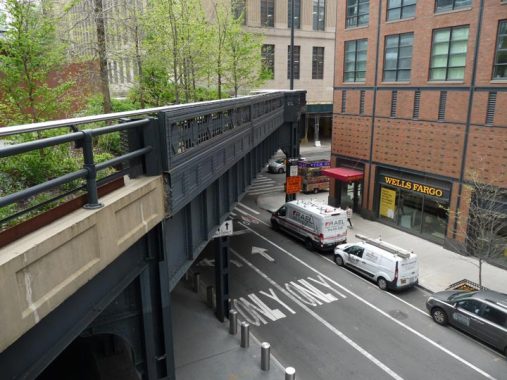

The final spur of the High Line opened in the summer of 2019. It’s a small spur spanning 10th Avenue at West 30th. Formerly, a trackway here went directly into the Morgan General Mail Facility, a building that currently is the main distributor of NYC’s mail; the James Farley Post Office, West 31st-33rd between 8th and 9th Avenues, has been transformed into a Penn Station extension called the (Sen. Daniel) Moynihan Train Hall.
Rotating artworks will appear on the overpass spanning 10th Avenue. The striking figure here is Simone Leigh’s “Brick House,” which was supposed to remain through September 2020, but is still here in April 2021. The High Line website described it thusly:
Brick House references numerous architectural styles: Batammaliba architecture from Benin and Togo, the teleuk dwellings of the Mousgoum people of Cameroon and Chad, and the restaurant Mammy’s Cupboard in Natchez, Mississippi. The sculpture contrasts sharply against the landscape it inhabits, where glass-and-steel towers shoot up from among older industrial-era brick buildings, and where architectural and human scales are in constant negotiation. Resolutely facing down 10th Avenue, Leigh’s powerful Black female figure challenges us to consider the architecture around us, and how it reflects customs, values, priorities, and society as a whole.
One of the new Hudson Yards buildings I’m somewhat curious about is its public events venue, The Shed, whose exterior shell can expand and contract to create more or less public space. The details of the unique technology are seen on this page. I had been unaware that the building is officially called The Bloomberg Building. Is it named for the former mayor, or the technology company he had established?

Since the High Line is closed at night, it has little need for lighting or streetlamps, but unique lamps (no doubt using LED bulbs) were developed for use at the entrance and exit staircases. Here, 10 Hudson Yards is the backdrop for one of these.

The original West Side Freight Railroad was built with occasional jogs. These are put to good use as viewing platforms at High Line Park, as with this one jutting over West 30th Street. Note that the developers chose to maintain the RR’s original railings whenever possible.

Here’s #508 West 29th, an apartment building that may have predated the opening of the West Side Freight Elevated in 1932. For years, there must have been one heck of a commotion when freight trains rattled past. Here it is in 1940.
On occasion, railroad rails, ties and ballast were left in place, or actually installed, to give the flavor of an active railroad in High Line Park. No trains have run through here since 1980.

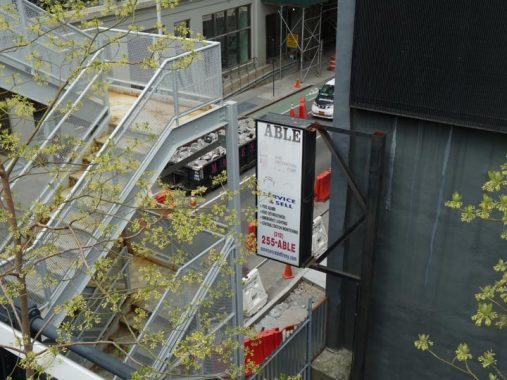
Interestingly, though Able Fire Extinguishers has moved east on West 26th to #245 between 7th and 8th Avenues, its old location at #513, by the High Line, still has the old illuminated sign; the building is now home to the Steven Kasher art gallery.

Meanwhile, the loft #508 West 26th, known as the Wolf Building, is still abiding as it always has. Note the jutting viewing platform at top left.
Above the door, there seems to be a missing “F.” That’s because as Annik LaFarge’s Livin’ The High Line explains, this used to be the home of Wolff Book Manufacturing Company, a bookbinding company.

A pair of walkup buildings, #514 and #516 West 25th Street.

Spring blooms can be seen on the High Line looking east on West 25th toward 10th Avenue. #250 10th Avenue, on the left, is the former warehouse of wholesale grocery company R.C. Williams , built in 1933; the company was among the first to ship goods on the High Line. Famed architect Cass Gilbert designed it in the same style as his larger Brooklyn Army Terminal in Sunset Park. the building was later home to Avenues World School. On the right is the new square-windowed tower #500 West 25th Street.

#519 West 24th, in the center of the block, is now home to the Metro Pictures art gallery but in 1940 it was a parking garage, of all things.
The High Line winds its way through a thicket of new glass-walled apartment buildings. If you look closely, you can see what I consider a design flaw in the walkway, which has short ises near the edge of the foliation. More than once, I’ve nearly tripped over these, and I wouldn’t be surprised if someone turned an ankle on them. Also in view is one of the High Line’s unique stairway lampposts.

At West 23rd Street and 10th Avenue, actually taking up the entire block defined by 9th, 10th, 23rd and 24th, is one of my favorite apartment complexes, London Terrace, so much so that I devoted an entire FNY page to it.
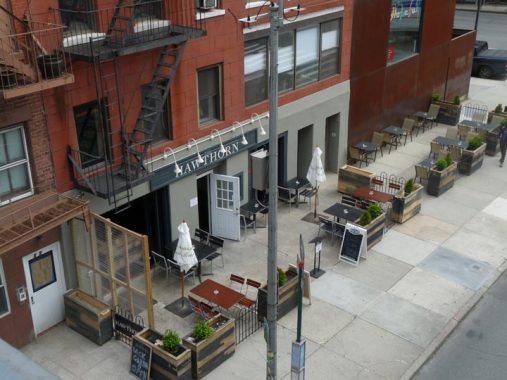
The Hawthorn, #507 West 23rd, has replaced The Half King, which was part authors,’ photographers,’ war correspondents’ and playwrights’ haunt and part neighborhood tavern opened by author Sebastian Junger (“The Perfect Storm”) in 2000; high rents forced it to close in 2019. I was only in once, and I was all wet. I had spent a day riding around in the fireboat John J. Harvey with the Newtown Historical Society‘s Christina Wilkinson, and just before returning to port, the jets were turned on while we were standing on deck and we were completely drenched. We made our way to the Half King and dried out there. Christina says that’s one of the few times she heard me erupt in a fusillade of cursing.

The Ten23 Apartments are a new complex at 10th Avenue and West 23rd. This mobile-like art installation in the rear wasn’t installed by the High Line’s developers, but looks as if it might have been.

I was thwarted by construction netting when trying to photograph one of the last remaining REVS VS. COST painted graffiti on West 23rd. The two graffitists Revs and Adam Cost actually worked together to create “street art” canvases in the 1990s. The building it’s on, #514 West 23rd, opened as a cigarette factory in the 1880s and later became a furniture warehouse; today it’s what else, luxury residences. The building can more clearly be seen here.

The arch-roofed brick building in the center, #526 West 22nd, is the home of the Comme des Garçons boutique, but in what’s become a NYC tradition, it maintains the metal sign of a previous tenant, Heavenly Body Works, which wasn’t a women’s workout studio but an auto collision repair shop.

A look at the parking lot directly under the High Line at West 22nd Street.

A thickly planted area on the High Line at West 22nd.

At 10th Avenue and West 20th-21st Streets the west end of the General Theological Seminary, an Episcopal institution, comes into view.
Thomas Clarke, a retired British seaman, bought acreage in this area (roughly between West 14th and 23rd Streets and 7th Avenue west to the river), naming it for Chelsea Hospital in London, a facility corresponding to NYC’s Sailors Snug Harbor, a retirement place for retired seamen. His son was Clement Clarke Moore, of ‘”Twas the Night Before Christmas” fame.
Architect George Coolidge Haight designed and built the various Gothic Revival buildings of the Seminary, including the Chapel of the Good Shepherd, between 1827 and 1902. The Seminary grounds had been an apple orchard owned by Clement Clarke Moore, an academician who was Professor of Oriental and Greek literature, as well as divinity and biblical Learning at the General Theological Seminary, which had been founded in 1817; Moore donated part of his property for the new Seminary buildings. Moore anonymously published the holiday poem “A Visit From St. Nicholas” in a Troy, NY newspaper in 1823; he did not publish it with a byline until 1844. Moore’s depiction of Santa Claus in the poem, combined with Thomas Nast’s depictions, helped to solidify The Jolly One’s present image. The Seminary has a magnificent library and the campus, accessible from 9th avenue, is an urban oasis of quiet.
For an idea of how the view has changed along the High Line, and not for the better, check these two images, once from Street View at an indetermined date (probably 2011) and April 2021. The sky is now hidden behind several very ugly buildings, including a pair of buildings I call Shoggoth Style, after H.P. Lovecraft’s pulsing, gooey monsters guarding the Old Ones’ ancient city in At the Mountains of Madness.

#511 West 20th, another walkup that must have preceded the High Line that likely dealt with plenty of noise from rattling engines.


At the bend in the High Line at 10th Avenue and West 17th, strollers used to have a fine view of one of Frank Gehry‘s few completed major NYC projects to date (in addition to the Beekman Tower downtown), the IAC (InterActive Corp) Building. IAC Chairman and CEO Barry Diller and wife, fashion designer Diane von Furstenberg, contributed thousands to assist High Line Park.
However those views have been co-opted by developers constructing overbearing towers adjoining the High LIne. Construction shedding, which can be in place for years, is also spoiling the views.

Brazilian muralist Eduardo Kobra’s tribute to Mother Teresa and Mohandas Gandhi can be seen at 10th Avenue and West 18th Street. Also note the pair of carriage houses adjoining it, #461 and 463 West 18th.
One of the more intriguing elements the High Line’s designers included in the park is the overlook at 10th Avenue and West 17th, complete with bleacher-type seating that allows strollers to plop down and observe traffic on the busy thoroughfare.

The High Line spur that formerly entered the Merchants Refrigeration Company (1917) now home to NYC’s Drug Enforcement Agency has been augmented by Ghanaian artist Ibrahim Mahama‘s “57 Forms of Liberty,” an artwork he fashioned from an old industrial tank. The title recalls NYC’s Statue of Liberty and 1957, the year Ghana attained independence from Great Britain. The work will be in place for much of 2021.
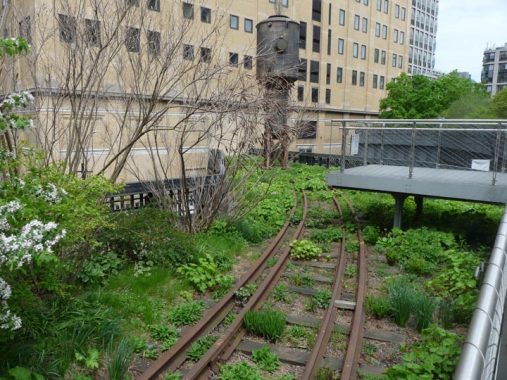
Another look at the spur track and an observation deck.


The gate at the head of what was Pier 54, is the last remnant of a terminal building for White Star ocean liners. Having been preserved by serendipity, it’s now part of Hudson River Park. One of the spectacular ocean liners that used this gate in their heyday would have been the Titanic, though he great liner was due to arrive at nearby Pier 58 — if fate had not intervened. It was there that passengers from the doomed vessel debarked after they were picked up in the icy North Atlantic Ocean by the Carpathia, operated by Cunard.
This is where the RMS Lusitania, the fastest, one of the most luxurious, and second largest liner in the world departed on its final voyage. On May 1st 1915, 1900 people departed Pier 54 for a voyage that would be implanted in the memory of folks for years to come. On the 7th of May, the Lusitania was torpedoed by a German U-boat, sinking in 18 minutes, and taking 1200 victims down with it.
Most of Pier 54 has been demolished, and a new island park, Little Island, is under construction. The park will not be officially part of Hudson River Park; instead, it is being privately funded and built by the aforementioned Barry Diller and Diane Von Furstenberg. The park is constructed on 132 golf tee-shaped pylons sunk into the Hudson River bed. The park will contain nature trails, hills, and a 700-seat amphitheater. Its design is by Thomas Heatherwick, who also designed “The Vessel,” the climbing structure in Hudson Yards further north. The island park is scheduled to open in the spring of 2021.
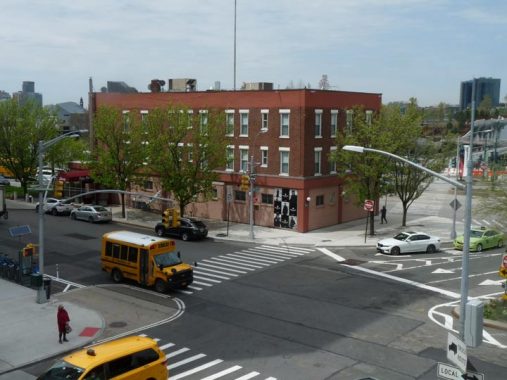
The Liberty Inn, sitting in the triangle formed by 10th and 11th Avenues and West 14th Street, was built all the way back in 1908 as the Strand Hotel, and catered to sailors working at the then-busy waterfront. It is most familiar in its current incarnation as a hot sheets hotel catering to travelers on the busy “Joe DiMaggio Parkway” though most call it 11th Avenue or the West Side Highway. The Liberty’s other incarnation has been the gay club called The Anvil. During the week, the hotel closes at midnight.

You can see a smidge of the glass tower named the High Line Building built atop a pre-existing Moderne meatpacking depot from 1938 here at West 14th Street, where there is an exit to the street below. We’re now entering the Meatpacking District, which had many more wholesale meat purveyors in 2006 than it does now. The 1938 building bestraddled the tracks, where goods could be loaded and unloaded.

West 14th Street, looking west from the High Line. The Belgian block streets were formerly stained with the blood of beeves, lamb and pork slaughtered and packed on these streets. Now, this is a high fashion district; a massive Apple retail store occupies a building formerly home to Western Beef.

For me the most fascinating section of the High Line is the southern end, as many of these buildings formerly home to meat wholesalers go back all the way to the 1880s or earlier.
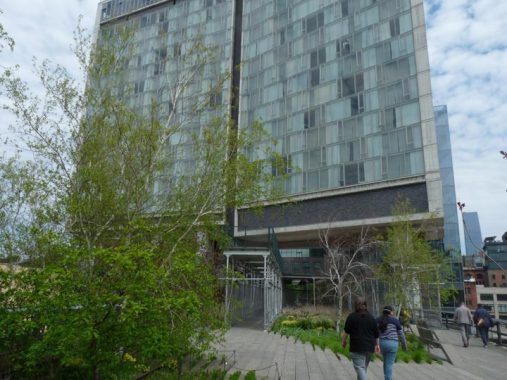
Patrons at The Standard Hotel, which straddles the High Line like a colossus, formerly have parkgoers a thrill when their windows were left uncurtained. For be it from me to look for something I shouldn’t see. Though a number of older buildings were built on top of the freight railroad and loaded goods on and off railroad cars on the tracks, the Standard, built in 2009, is the only brand new building built over what by then was the High Line. It is 20 stories tall and 245 feet high.
Some of the best High Line plantings were installed along with some remaining train tracks at the park’s southern end.
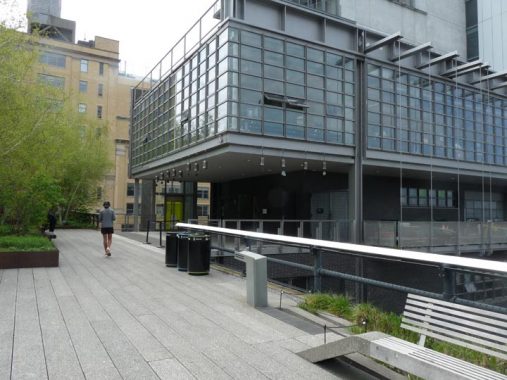
I had been thinking that, perhaps, a direct entrance to the new Whitney Museum on Gansevoort Street would be included at the High Line’s southern end, but instead, this is the park’s administration building, named for Diller and Von Furstenberg. It does include a welcome rest room.

Rebecca Belmore’s “I Heard a Siren Singing” sculpture to me looks like something out of Renaissance-era French surgeon Ambroise Pare’s collection of human monsters.
At the south end of the High Line you can see a former warehouse of the Manhattan Refigeration Company. The railroad formerly went straight through the building and you can see where the opening has been covered up by artwork. It’s a complex of eight buildings constructed between 1898 and 1926.
I got several more shots of the High Line from the street…but those will wait for another post.
As always, “comment…as you see fit.” I earn a small payment when you click on any ad on the site.
5/2/21

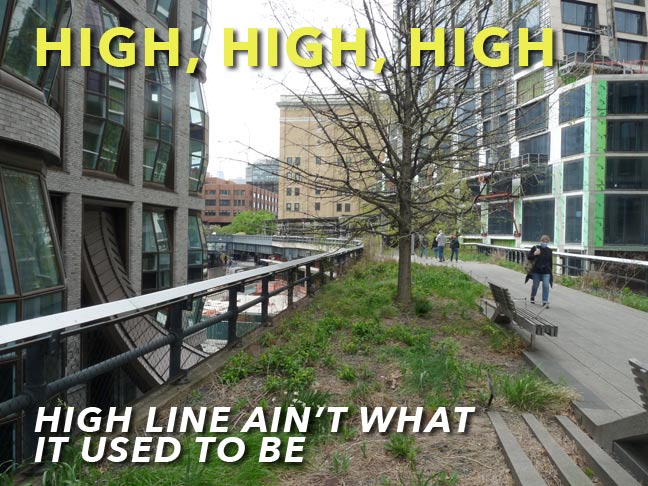
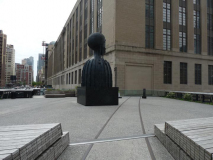
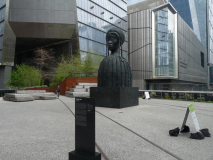
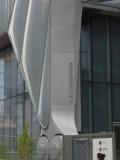
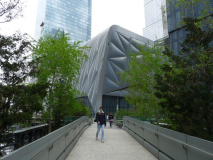
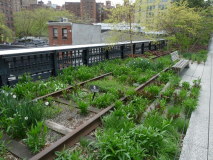
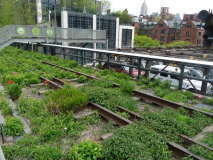
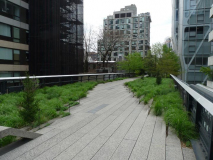
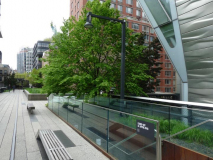
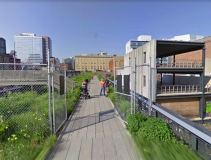
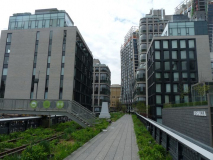
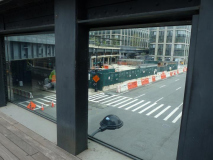
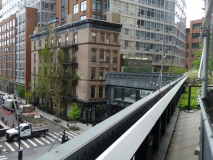
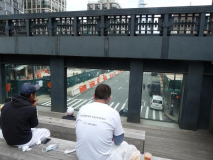
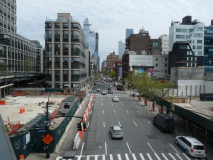

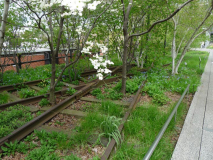
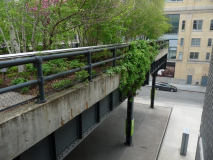
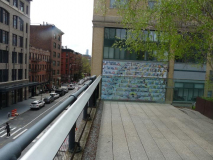
18 comments
The arch-roofed building on 22nd St with the Heavenly Bodies sign is the Comme Des Garcons boutique at 520. Matthew Marks Gallery is the arch-roofed building next to it at 526.
Lived in London Terrace then. We were literally wined andined. (Free buffet wine in the courtyard) by the principals and real estate people. Hudson River Park is 2 blocks away where you can walk your dog skate bike sit in the sun or have a drink. You can do none of those on the highline
The pitch to merchants was more foot traffic. Yes but at the exits only. Chelsea was already gentrifying no doubt but The influx of rich people priced us out of Cheksea (My family since the 1960s). So the the hardware bodegas and other services left too. I was the only regular resident on my floor. All the rest pied-a-terres.
Real estate developers always figure out how to ruin EVERYTHING. Just a bunch of clueless greedy assholes.
It goes back forever, fighting neighborhoods to knock down vintage architecture and community spaces but then having the gall to use the exact attributes they’re destroying to use in sales literature to sell it to wealthy buyers.
I actually hope that developers overbuild all around the Highline until there are no views left and tourists stop coming, (‘it used to be nice until all these buildings went up and blocked the views’) and everyone can use this as a prime example of how developers are morons.
Alas, it the same the world over. I live in London (England) and once solidly working class districts with a wealth of beautiful, but neglected buildings, have been colonised by people looking for the next ‘up and coming’ area. Shoreditch, which is on the edge of the ‘old’ City, has been all but ruined by out of place developments and the takeover by brands.
Re: bleacher seating at 17th Street: I think you meant “busy thoroughfare”? Thinking the “busty thoroughfare” might be the Deuce, pre-Disneyfication… but that would be a purely hypothetical, since I was NEVER there. I swear NEVER!
all right, all right.
I will restrain myself and just say that I am glad NY taxpayers did not pay for this.
They did. A WHOLE lot of state and federal money went into the highline. “The total cost for Section One and Two of the High Line is $152.3 million. The design and construction cost of the section of the park that opened today is $86.2 million. Funding for the project includes $112.2 million from the City, $20.3 million from the federal government, and $400,000 from the State.Jun 11, 2009”
great shots, thanks again Kevin.I can’t believe how clean the streets are. There is no litter. DSNY doing a nice job!
NYC is losing all its unique character. We’re just a few years away from it becoming one collossal, soulless glass and steel purgatory. Might as well live in downtown Cleveland.
Thank you for your article. I’m one NYer who also enjoys the High Line. I miss the views that are being increasingly hidden by development, but it still fascinates me!
There was also a talk about extending the 7 train to Secaucus, but that idea was stopped possibly because the PANYNJ didn’t want the subway to rival with either PATH or NJ Transit.
Lived in London Terrace for 10 years beginning in 2005. The views over the undeveloped highline from my upper floor apartment were glorious. I absolutely loved the high line park when it first opened and before it was in the tourist books. I would run up and down its length, to the gym and back, and it was empty, beautiful, airy. I marveled how viewing the neighborhood from 20 feet up completely changed one’s perspective; an entirely new appreciation for architecture and infrastructure. I still love the highline on return visits to the neighborhood, but the condo canyon has radically changed the feel. The first few that went in were beautiful, interesting, but there have been some hideous additions since, and that combined with the crushing crowds and the parade of selfie-takers pushing down from Hudson Yards have certainly changed things.
Imagine a “prequel” to “Idiocracy”. The perfect filming location would be the Highline, a place where the nomenklatura claim to love humanity by showing contempt for the rest of us by planning a transition to this:
https://www.bing.com/videos/search?q=idiocracy+movie&&view=detail&mid=708245FE17EF432C1F07708245FE17EF432C1F07&&FORM=VRDGAR&ru=%2Fvideos%2Fsearch%3Fq%3Didiocracy%2Bmovie%26%26FORM%3DVDVVXX
Many of the “Rails-to-Trails” parks, like the High Line, are bound by restrictions that would allow their return to active rail use, however unlikely. This was the work-around
that was developed years ago to keep such spaces as this from becoming totally lost.
Perhaps it’s just me saying this, but I feel that High Line Park created gentrification for this neighborhood since it first came around especially seeing how everything that surrounds it seems expensive to live or work in.
Definitely, the High Line was a seed for gentrification. Definitely, it should have been returned to use as part of a railroad. Manhattan brings in vast amounts of retail merchandise, ships out massive amounts of garbage, and has tons of mail going both ways.
I am by no means familiar with New York City, but even I realised on consecutive visits (2018 and 2019) that there were views missing from my 2019 walks. Yes, The highline is a tourist draw and very busy, BUT if you are quick or patient it is possible to get photographs that are not filled with people. I was pleased to learn that the spur had been completed and have great pictures.